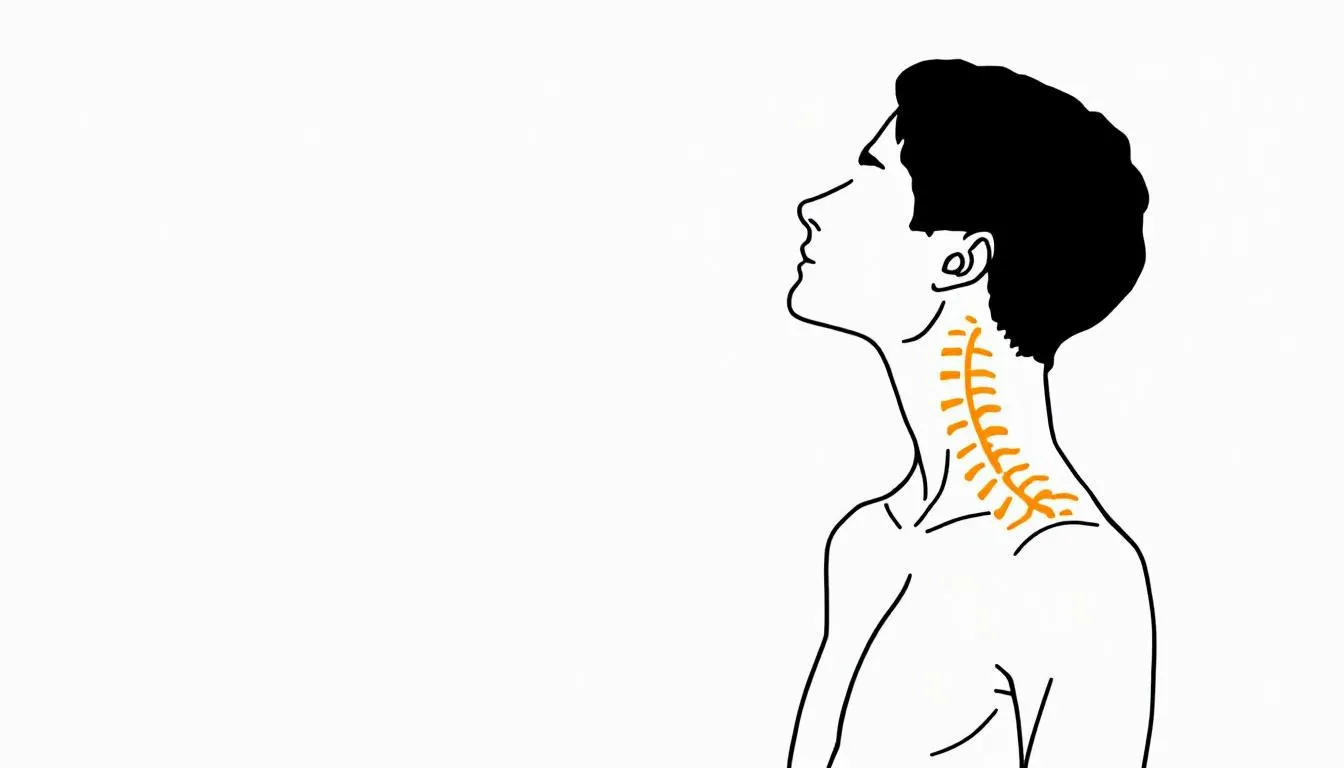Top Hump Neck Exercise to Improve Your Posture and Ease Pain

Are you dealing with a hump neck and need exercises to fix it? This guide provides simple and effective Hump Neck Exercise techniques to correct your posture and ease pain. Begin your journey to improved neck health today.
Key Takeaways
- Hump neck, or dowager’s hump, is often caused by poor posture, particularly forward head posture, leading to discomfort and misalignment.
- Effective exercises, such as chin tucks and scapular squeezes, along with stretching and strengthening techniques, can help correct hump neck and improve overall posture.
- Maintaining good posture, making ergonomic adjustments, and engaging in physical therapy can significantly support recovery and prevent the development of hump neck.
Understanding Hump Neck
Dowager’s hump is characterised by an outward curvature of the thoracic vertebrae, resulting in a rounded hunch that is often visible at the base of the neck. This condition is particularly prevalent among older adults, with studies showing a prevalence rate of 20% to 40% in this demographic. The term “dowager’s hump” specifically refers to this vertebral misalignment, which differentiates it from a buffalo hump, where fat accumulation occurs at the neck base. Treating dowager’s hump is essential for improving posture and overall health, and can help correct a dowager’s hump. Incorporating dowager’s hump exercises can also be beneficial. Additionally, abnormal curvature may contribute to the development of this condition.
The misalignment associated with a hump neck can lead to significant discomfort and pain, impacting daily activities such as turning your head or maintaining good posture. Understanding the nature of this condition is the first step towards addressing it effectively and improving your quality of life.
Common Symptoms of Hump Neck
One of the most noticeable symptoms of hump neck is the forward head posture, where the head leans forward more than usual. This can lead to neck and shoulder pain, particularly when performing certain movements or maintaining a position for an extended period. The discomfort is often felt in the neck and upper back, making everyday tasks challenging.
In addition to pain, many individuals experience pain and discomfort and stiffness around the neck muscles and shoulder blades. In more severe cases, looking upwards or turning the head can become difficult due to the muscles surrounding these areas. These symptoms can significantly affect daily life, making it essential to address neck pain promptly and effectively.
Causes of Hump Neck
Poor posture, especially forward head posture, is a primary cause of hump neck. When the head is consistently positioned forward, it places additional strain on the neck and spine, leading to discomfort and misalignment. Weakening of the muscles that support the thoracic spine can also contribute to this condition, causing compensatory strain on other muscle groups.
Hump neck is more common in postmenopausal women due to hormonal changes that affect bone density, leading to spinal degeneration. Other potential causes include muscle weakness, sensory changes, and various medical conditions. Understanding these causes can help in developing effective strategies to correct and prevent the condition.
Effective Exercises to Correct Hump Neck

Exercises play a crucial role in correcting hump neck by strengthening the muscles and improving neck alignment. Among the most effective hump exercises are chin tucks and scapular squeezes. These exercises target key muscle groups and help in realigning the spine, promoting better posture, and reducing discomfort.
Chin Tucks
Chin tucks are an excellent exercise for targeting the deep cervical muscles, which are crucial for maintaining proper neck alignment. To perform a chin tuck:
- Sit or stand with good posture.
- Retract your chin backwards, creating a double chin effect. Incorporating chin retractions can enhance this exercise.
- Hold this position briefly before releasing.
- Repeat several times to help correct the dowager’s hump and improve neck alignment.
Consistent practice of chin tucks can significantly reduce the rounded hunch and enhance overall posture. This simple yet effective exercise can be easily incorporated into your daily routine, making it an accessible solution for those looking to get rid of a neck hump.
Scapular Squeezes
Scapular squeezes are another vital exercise for improving shoulder blade positioning and strengthening the upper back muscles. To perform this exercise:
- Sit or stand with your arms at your sides.
- Squeeze your shoulder blades together. Make sure your shoulders are going back and down.
- Hold the position for a few seconds before releasing.
- Repeat several times to enhance the strength of the upper back muscles and alleviate neck and shoulder pain.
Regularly performing scapular squeezes corrects muscle imbalances and improves the alignment of the neck and upper back. This exercise is particularly beneficial for those dealing with hump neck as it addresses the root causes of the condition and promotes better posture.
Stretching Techniques for Hump Neck

Stretching techniques are essential for relieving tension and enhancing flexibility in the neck and upper back. Two effective stretches for addressing hump neck are the pectoral stretch and the upper back stretch. These techniques help alleviate symptoms, improve posture, and reduce discomfort associated with a dowager’s hump.
Pectoral Stretch
The pectoral stretch is designed to relieve tension in the chest muscles, which often contribute to poor posture and rounded shoulders. To perform this stretch from the starting position:
- Stand in a doorway with your arms at a 90-degree angle against the door frame.
- Lean forward until you feel a stretch in your chest muscles.
- Maintain the position for a few seconds.
- Release the stretch.
- Repeat several times to help reduce the rounding of the shoulders and improve overall posture.
Incorporating pectoral stretches into your exercise routine can significantly enhance your posture and relieve associated discomfort. Counteracting the tightness in the pectoral muscles helps strengthen muscles and achieve a more balanced and aligned posture.
Upper Back Stretch
The upper back stretch is designed to restore range of motion in the back muscles and enhance flexibility in the neck and upper back. To perform this stretch:
- Stand facing a wall.
- Place your hands flat against the wall above your head.
- Maintain a neutral neck position.
- Move slowly, starting with small movements to avoid strain.
- Repeat several times to improve mobility and reduce discomfort.
This stretch is particularly beneficial for those dealing with forward head posture and neck hump, as it helps alleviate tension and promote better alignment of the neck and upper back in a neutral position, keeping the upper spine straight, with palms facing forward and upper vertebrae. Additionally, incorporating a pec stretch can further enhance flexibility, making a step forward in improving overall posture.
Postural Adjustments to Prevent Hump Neck

Good posture is essential to avoid the development of a neck hump, as slouching increases strain on the back and neck. To improve spinal health and reduce the risk of developing a dowager’s hump, consider the following:
- Be mindful of your posture and consciously straighten your spine during daily activities.
- Take regular breaks from screens.
- Make ergonomic adjustments to your workspace to alleviate tension and reinforce proper posture throughout the day.
Exercises aimed at correcting hump neck, such as chin tilts and scapular squeezes, can enhance posture and reduce associated pain. These postural exercises target smaller muscles in the back, helping to restore balance and strength affected by postural changes.
Improving your posture can significantly alleviate the effects of kyphosis-related conditions, such as a dowager’s hump and thoracic hyperkyphosis. When you focus on your bad posture, you can stand tall and feel more confident.
The Role of Physical Therapy in Treating Hump Neck

Engaging in physical therapy can significantly enhance the treatment outcomes for hump neck by developing a tailored exercise regimen. Physical therapists collaborate with medical professionals to guide patients in maintaining proper posture and performing exercises that strengthen the neck and back muscles. This professional guidance is crucial for effective recovery and long-term management of the condition.
Physical therapists also monitor progress and adjust treatment plans as needed, ensuring that patients receive the most effective care possible. Working with a physical therapist helps individuals achieve better neck alignment and reduce discomfort associated with a hump neck.
Acupuncture: Targeting the Root of Tension
Acupuncture uses fine needles to stimulate specific points on the body, triggering your body's natural healing response. This process increases blood flow to tight muscles, encouraging them to relax and release built-up tension. Many patients report experiencing immediate relief from neck and shoulder tension after treatment, along with an improved range of motion. By addressing the underlying causes of muscle tightness, acupuncture can be an effective complementary therapy for managing and alleviating symptoms associated with a hump neck.
Cupping: Creating Space for Better Alignment
This technique is particularly beneficial because forward head posture often involves layers of muscle and fascia that become "stuck" together. Cupping helps create space between these layers, allowing for better movement and positioning of your shoulders and neck. By gently lifting the skin and underlying tissues, cupping can reduce muscle tightness and promote improved blood flow, which supports the restoration of proper alignment and eases discomfort associated with a dowager's hump.
Gua Sha: Breaking Down Adhesions
This technique can be especially effective at addressing those stubborn knots and trigger points that develop over time. The scraping action helps reorganise tissue fibres and can significantly reduce muscle tension, promoting better blood flow and enhancing the healing process. By gently breaking down adhesions, Gua Sha encourages the muscles and fascia to relax, which can improve mobility and reduce discomfort associated with tight upper back muscles and poor posture.
Lifestyle Changes to Support Hump Neck Recovery
Ergonomic adjustments in your daily routine are crucial for maintaining spinal alignment and supporting recovery from hump neck. Holding devices at eye level and setting up a workspace so that the phone or computer screen is at eye level can prevent neck bending and promote better posture. These adjustments can significantly reduce the risk of developing a dowager’s hump and alleviate existing symptoms.
Adopting a balanced diet and regular physical activity can also help reduce excess fat accumulation that contributes to a neck hump. Incorporating these lifestyle changes with ergonomic adjustments supports long-term recovery and improves overall spinal health.
Summary
In summary, addressing a dowager’s hump requires a multifaceted approach that includes understanding the condition, recognising symptoms, and knowing the causes. Effective exercises and stretching techniques, along with postural adjustments and lifestyle changes, play a crucial role in improving neck alignment and reducing discomfort.
By taking proactive steps and possibly seeking guidance from a physical therapist, you can manage and even correct a neck hump. Remember, consistent effort and mindful practices are key to achieving a healthier posture and easing the pain associated with this condition.
Frequently Asked Questions
What is the main cause of a dowager's hump?
A dowager's hump is primarily caused by poor posture, especially forward head posture, which puts extra strain on your neck and spine. Improving your posture can help mitigate this issue.
Can exercises help in correcting a dowager's hump?
Absolutely, exercises like chin tucks and scapular squeezes can really help improve neck alignment and alleviate symptoms of a dowager's hump. It's all about staying consistent and engaging those muscles!
How does physical therapy assist in treating hump neck?
Physical therapy helps treat hump neck by creating personalised exercises and promoting good posture, essential for your recovery. It’s all about getting you back to feeling your best!
What lifestyle changes can support recovery from hump neck?
Making ergonomic adjustments to your workspace and holding devices at eye level can significantly help with hump neck recovery. Don't forget to incorporate a balanced diet and regular exercise into your routine for overall wellness!
Are stretches effective in relieving symptoms of dowager's hump?
Absolutely, stretches like the pectoral and upper back stretches can help relieve symptoms of dowager's hump by improving posture and reducing discomfort. Give them a try and you might just feel a difference!